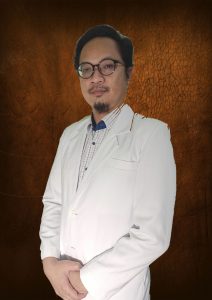2. The journal allows the author(s) to retain publishing rights without restrictions.
3. The legal formal aspect of journal publication accessibility refers to Creative Commons Attribution (CC BY).
Background: Post-stroke pain (PSP) and musculoskeletal complications significantly hinder recovery and quality of life in stroke survivors. Prolotherapy, a regenerative injection therapy, has shown promise in managing musculoskeletal disorders but remains underexplored for PSP.
Aim(s): This study evaluates the effectiveness of prolotherapy in reducing pain, improving range of motion (ROM), and enhancing functional outcomes in PSP patients.
Material and methods: This pilot study employed a pre-experimental design with pretest and posttest measurements. Conducted at RSUD Dr. Saiful Anwar Malang, the study included three stroke patients experiencing chronic musculoskeletal pain. Prolotherapy injections containing hypertonic dextrose were administered at regular intervals. Primary outcomes included pain (Numerical Rating Scale), ROM, and spasticity (Modified Ashworth Scale). Secondary outcomes were assessed using the Barthel Index, Short Form-36, and Fugl-Meyer Assessment. Statistical analyses were descriptive, with paired t-tests applied to outcome changes.
Result: Significant improvements in pain levels (mean NRS reduction from 5.67±1.5 to 3.0±2.0) and ROM, particularly in shoulder flexion and wrist extension, were observed. Spasticity showed minor improvements in some muscle groups. Functional outcomes, including Barthel Index and SF-36 scores, demonstrated positive trends, with two participants improving from severe dependency to moderate independence.
Conclusions: Prolotherapy shows promise as an adjunctive intervention for PSP, offering potential benefits in pain reduction and functional recovery. As the first study of its kind at RSUD Dr. Saiful Anwar Malang, it lays the groundwork for future large-scale research to validate these findings and refine clinical applications.
Keywords: Stroke, Prolotherapy, Pain, Rehabilitation, post-stroke pain, functional performance
Setyopranoto I, Bayuangga H, Panggabean A, Alifaningdyah S, Lazuardi L, Dewi F, et al. Prevalence of stroke and associated risk factors in Sleman District of Yogyakarta Special Region, Indonesia. Stroke Res Treat. 2019;2019:2642458. doi:10.1155/2019/2642458.
Liampas A, Velidakis N, Georgiou T, Vadalouca A, Varrassi G, Hadjigeorgiou G, et al. Prevalence and management challenges in central post-stroke neuropathic pain: A systematic review and meta-analysis. Adv Ther. 2020;37:3278-91. doi:10.1007/s12325-020-01388-w.
Choi H, Aktas A, Bottros MM. Pharmacotherapy to manage central post-stroke pain. CNS Drugs. 2021;35:151-60. doi:10.1007/s40263-021-00791-3.
Taheem Y, Suvar T. Prolotherapy: Review with background history, mechanism of action, and current evidence. ASRA News. 2022. doi:10.52211/asra080122.035.
Waluyo Y, Artika SR, Wahyuni IN, Gunawan A, Zainal ATF. Efficacy of prolotherapy for osteoarthritis: A systematic review. J Rehabil Med. 2023;55:2572. doi:10.2340/jrm.v55.2572.
Dwivedi S, Sobel AD, Dasilva M, Akelman E. Utility of prolotherapy for upper extremity pathology. J Hand Surg. 2019;44(3):236-9. doi:10.1016/j.jhsa.2018.05.021.
Chen CL, Chen CY, Chen HC, Wu CY, Lin KC, Hsieh Y, et al. Responsiveness and minimal clinically important difference of Modified Ashworth Scale in patients with stroke. Eur J Phys Rehabil Med. 2019. doi:10.23736/S1973-9087.19.05545-X.
Patel C, Limbasiya RD, Gandhi N. Electrophysiological evaluation of the Modified Ashworth Scale in assessment of post-stroke ankle plantar spasticity. Int J Health Sci Res. 2021. doi:10.52403/ijhsr.20210815.
Rech KD, Salazar AP, Marchese R, Schifino G, Cimolin V, Pagnussat A. Fugl-Meyer Assessment scores are related with kinematic measures in people with chronic hemiparesis after stroke. J Stroke Cerebrovasc Dis. 2019. doi:10.1016/j.jstrokecerebrovasdis.2019.104463.
Dasukil S, Arora G, Shetty S, Degala S. Impact of prolotherapy in temporomandibular joint disorder: A quality of life assessment. Br J Oral Maxillofac Surg. 2020. doi:10.1016/j.bjoms.2020.10.014.
Sam N, Yusuf I, Idris I, Adnan E, Haryadi RD, Hamid F, et al. Effectiveness of prolotherapy combined with physical therapy versus physical therapy only for frozen shoulder: A case report. Am J Case Rep. 2022;23. doi:10.12659/AJCR.936995.
Karim SA, Hamid MS, Choong A, Ooi MY, Usman J. Effects of platelet-rich plasma and prolotherapy on supraspinatus tendinopathy: A double-blind randomized clinical trial. J Sports Med Phys Fitness. 2023;63(5):674-84. doi:10.23736/S0022-4707.22.14376-8.
Khanna M, Sivadas D, Gupta A, Haldar P, Prakash N. Impact of inpatient rehabilitation on quality of life among stroke patients. J Neurosci Rural Pract. 2022;13:800-3. doi:10.25259/JNRP-2022-1-18-R1-(2322).
Ferfeli S, Galanos A, Dontas I, Triantafyllou A, Triantafyllopoulos IK, Chronopoulos E. Reliability and validity of the Greek adaptation of the Modified Barthel Index in neurorehabilitation patients. Eur J Phys Rehabil Med. 2023. doi:10.23736/S1973-9087.23.08056-5.
Sylaja P, et al. Ayurvedic treatment in the rehabilitation of ischemic stroke patients in India: A randomized controlled trial study protocol. Cerebrovasc Dis. 2023;52:609-15. doi:10.1159/000530546.
Sun C. The impact of neurorehabilitation on the motor function and independence of patients with post-stroke hemiplegia. Clin Neurosci Res. 2023. doi:10.26689/cnr.v1i2.5253.
Shi Y, Liu F, Li S, Chen J. Accounting for pilot study uncertainty in sample size determination of randomized controlled trials. Stat Biopharm Res. 2020;13:192-202. doi:10.1080/19466315.2020.1831951.
Álvarez G, Núñez-Cortés R, Solá I, Sitjà-Rabert M, Fort-Vanmeerhaeghe A, Fernández C, et al. Sample size, study length and inadequate controls were the most common self-acknowledged limitations in manual therapy trials: A methodological review. J Clin Epidemiol. 2020. doi:10.1016/j.jclinepi.2020.10.018.
Muggleton E. Pilot randomised controlled trial reporting should be focused. Anaesthesia. 2020;75. doi:10.1111/anae.15189.
Sim J. Should treatment effects be estimated in pilot and feasibility studies? Pilot Feasibility Stud. 2019;5. doi:10.1186/s40814-019-0493-7.
Jung SH, Park E, Kim JH, et al. Effects of self-rehabilitation video exercises (SAVE) on functional restorations in patients with subacute stroke. Healthcare. 2021;9. doi:10.3390/healthcare9050565.
Almutairi SM, Khalil ME, Almutairi NM, Alenazi AM. Effects of neuromuscular electrical stimulation on plantarflexors spasticity, gait performance, and self-reported health outcomes in people with chronic stroke: A study protocol for a double-blinded randomized clinical trial. Front Neurol. 2021;12. doi:10.3389/fneur.2021.770784.
Copyright (c) 2025 Dwi Indriani Lestari, Rahmad, Gutama Arya Pringga, Sheilla Elfira San Pambayun, Ferdian Musthafa, Yuan Laura Puspitasari, Ichsan, Syeda Tazkia Noor, Dilloniar Bahny Zulfikar, Maydah Ariani

This work is licensed under a Creative Commons Attribution 4.0 International License.
1. The journal allows the author to hold the copyright of the article without restrictions.
2. The journal allows the author(s) to retain publishing rights without restrictions.
3. The legal formal aspect of journal publication accessibility refers to Creative Commons Attribution (CC BY).




